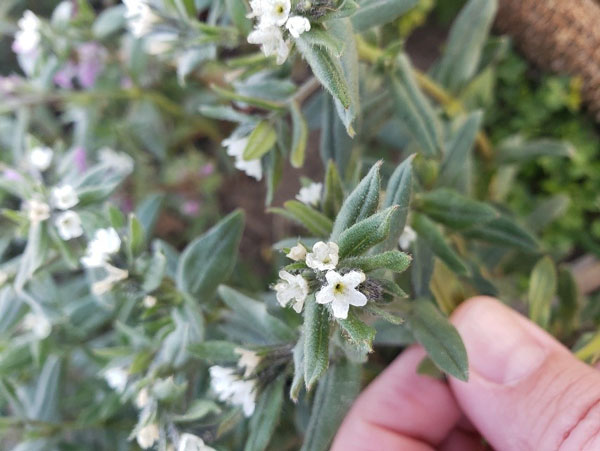It has been a while since the last World of Weeds feature, but we have a timely article for the month of April. Corn gromwell (Buglossoides arvensis) is currently flowering in no-till field areas around northeast Kansas (Figure 1). It is a member of the Boraginaceae family, which includes the popular bedding plants forget-me-not and comfrey, but no other weeds of agronomic importance in Kansas.

Figure 1. Corn gromwell growing in corn residue at the Kansas River Valley Experiment Field. Photo by Eric Adee, K-State Research and Extension.
Ecology
Corn gromwell is a winter annual or biennial that is native to Asia and Europe. The roots were historically used to make red dye for clothing. It can be found in fallow fields, pastures, gardens, fencerows, and roadsides throughout Kansas. It can be especially troublesome in winter wheat due to the similarities of their lifecycles. In addition, corn gromwell is well-adapted to dry summers and cold winters.
Identification
Seedlings of corn gromwell typically emerge in the fall. They have large cotyledons. Mature plants grow about 7 to 28 inches tall but are typically 1 to 2 feet in height. Stems often branch at the base, with the central stem usually being the largest. The stems are green to reddish-brown and have rough hairs. Leaves are 1/3 to 1.25 inches long. They attach directly to the stems (sessile) in an alternating pattern. They are lanceolate or linear in shape with one prominent midvein. Leaves are covered with short, stiff hairs on both sides.
White flowers about ¼ of an inch wide form at the ends of the stems (Figure 2). Flowers have five petals arranged in a funnel. The “neck” of the funnel is sometimes blue. Small seeds form in brown to grayish-tan, cone-shaped nutlets that are about 1/10 of an inch long.

Figure 2. Corn gromwell flowers and leaves. Take note of the five petals and the hairy leaves. Photo by Sarah Lancaster, K-State Research and Extension.
Management
There is little research on the control of corn gromwell. It is not easily controlled by “typical” herbicides applied in the early spring, including glyphosate. Additionally, there are reports that Group 4 herbicides 2,4-D and dicamba are not very effective. There are some reports that chlorsulfuron (Glean, others), metsulfuron (Ally, others) and prosulfuron (Peak) have limited activity. Some products that seem to be more effective include bromoxynil, and triasulfuron (Amber, others). Other herbicides labeled for control include glufosinate (Liberty, others), metribuzin (Dimetric, others), and tribenuron (Express, others).
The use of trade names is for clarity to readers and does not imply endorsement of a particular product, nor does exclusion imply non-approval. Always consult the herbicide label for the most current use requirements.
Sarah Lancaster, Extension Weed Management Specialist
slancaster@ksu.edu
Tags: World of Weeds corn gromwell